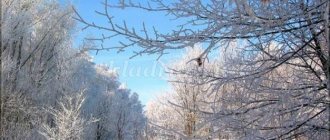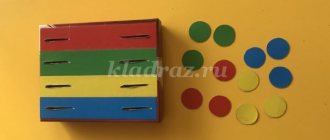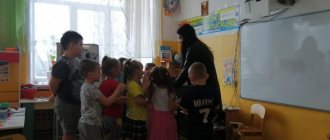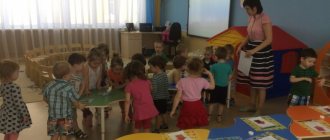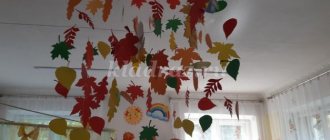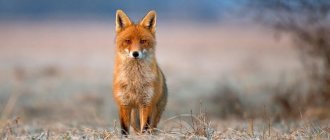Summary of educational activities for speech development in the nursery group “Our Pets”.
Summary of GCD for speech development
in the nursery group “Our Pets”.
Objectives: expand children's knowledge about domestic animals; enrich your vocabulary, name animals and actions (the concept of “pet” is in the passive dictionary); continue to learn how to construct sentences and answer questions; encourage them to be active and
independence.
Material: bag with animal toys (cow, horse, dog, cat, goat, pig).
Progress of the lesson
The teacher calls the children over and asks: “Look, guys, what is this magic bag we have here, who is hiding in it?” A voice is heard: “We! We!" "Who is this?"
He looks into the bag and asks in surprise: “Who is scratching here? What do you guys think?”
Cat
On the balcony outside the window there is a black and white spot. Now curled up, now sideways, Watching the sun with his eye. Ears, eyes, tail and paws, This is a Tsap-scratch cat. — A cat’s child is called a kitten. The kitten says: “Meow-meow.” Say it like a kitten says.
The teacher takes out a toy and asks to name who it is. Cow
A cow has horns and hooves on its legs. She chews grass and gives milk to the children. — A cow’s child is called a calf. The calf says: "Moo-oo." Say it like the calf says.
Another voice is heard: “Igo-go!” "Who is this?" Horse
The horse has a long mane and has a cheerful and playful disposition. She will eat the hay now, and give us a ride. - A horse's child is called a foal. The foal says: “i-go-go.” Say it like a foal says.
The teacher takes out a horse and invites the child to take a toy, asks questions: “Who saw the horse? Who was riding a horse? What was she like? Encourages children's initiative and their desire to answer independently.
The teacher continues: “Who else lives next to us? Woof! Woof! Woof! Who
This? Dog Bug. What does she ask the guys? A bone. Dog
The dog gnaws bones, bites evil people too - so that a thief does not get in, guards both the house and the yard. -A dog’s baby is called a puppy. The puppy says: “woof-woof.” Say it like a puppy says.
The teacher looks into the bag: “Who else do we have here?” Goat
The jumping goat, mischievous, butting, likes to sneak, eat cabbage from the garden. — A goat’s child is called a kid. He says: “Me-e-e.” Say it like the little goat says.
The teacher continues: “Who is this left in our bag?” Pig
The dirty pigs have bristles on their backs, a snout on their faces, and a thin hooked tail on their backs. - A pig's child is called a piglet. The pig says: “oink-oink.” Say it like the pig says.
These guys are all pets.”
At the end of the lesson, you can offer to play with animal toys:
build them houses, feed them, while asking questions:
“What he loves”, “What we will feed.” The teacher supports and encourages
children's initiative.
MAGAZINE Preschooler.RF
Outline of a comprehensive lesson for children of the first junior group “Fly, swim, go”Teachers: Kruglova I.I.
Integration of educational areas: “Cognitive development” , “Speech development” , “Socio-communicative development” , “Artistic and aesthetic development” , “Physical development” .
Tasks:
- consolidate the general concept of “transport” and its types; children's knowledge of primary colors ( "Cognitive Development" );
- develop coherent speech, vocabulary, speech hearing, erudition; form the grammatical structure of speech ( “Speech development” );
- to develop an interest in fiction through familiarity with the fairy tale by K. I. Chukovsky “Doctor Aibolit” ( “Speech Development” );
- enrich children’s motor experience through the active game “Train Engine” and the musical break “Airplane” ( “Physical Development” );
- actively and kindly interact with adults and peers ( “Social and communicative development” ).
Methods and techniques:
practical: game with musical accompaniment “Locomotive” , finger gymnastics “Fish” , low mobility game “Airplane” , dance exercises to the song “Airplane” ;
visual: looking at pictures depicting a railway, sea, mountains, road, train, car, ship, plane;
verbal: conversations and questions on the topic “Transport” .
Materials and equipment: Doctor Aibolit doll, telegram, ship made of wooden modules, chairs, steering wheel, hats of the driver, pilots, sailors, musical accompaniment: E. Zheleznova “Train Locomotive” , children's song “Airplane” ;
Forms of organizing joint activities
Children's activities Forms and methods of organizing joint activities
1. Communication
Conversations and questions on the topic; "Transport" , children's answers.
2. Perception of fiction (Doctor Aibolit).
3. Musical outdoor game with musical accompaniment (E. Zheleznova “Locomotive” , musical break “Airplane” .
4. Motor active game with musical accompaniment (E. Zheleznova “Locomotive” , musical break “Airplane” .
Progress of the lesson
1. Organizational moment. Emotional attitude towards educational activities.
A voice is heard: Oh-oh-oh!
What to do? How to be? How can I treat animals? Educator: Guys, who is so worried and worried about sick animals?
Children: Doctor Aibolit.
(Doctor Aibolit doll appears).
Educator: What happened, Doctor Aibolit? Why are you so sad? And what do you have in your hand?
Aibolit: I received a telegram from Hippopotamus.
(reads the telegram)
- “Come, doctor, to Africa as soon as possible and save, doctor, our babies.” - What to do, how to be? I need to treat my children.
But I don’t know at all how to get to Africa, because it is very far away.
Educator: Guys, do you feel sorry for Doctor Aibolit and sick animals? (children reason and express sympathy).
— Do you want to help Aibolit cure small animals? Are you ready to hit the road?
2. Examination of the image of the railway.
- Guys, what is this? (rails).
— What rides on rails? (train).
- What will we take on the journey? (by train).
- Certainly. You guys are great. You know everything!
— The carriages stand behind me. Go!
3. An outdoor game with musical accompaniment “Locomotive” .
(E. Zheleznova “Locomotive” ).
Doctor Aibolit: - How fun we had on the train!
4. Looking at the picture “Sea” .
Educator: And here in front of us the sea is raging, making noise in the open space. And a high wave is moving in the sea. Now it will swallow Aibolit.
Aibolit:
* Oh, what if I don’t make it, what if I drown, what will happen to them, to my forest animals.
Educator: Guys, what can Aibolit use to cross the sea?
Children: Ship, boat.
Educator: It’s a long time on a boat, it’s better on a ship. Let's get on the ship and sail.
5. Finger gymnastics “Fish”
(We imitate the movements of fish with our hands in accordance with the text)
The fish are frolicking merrily in the clean, warm water. Either they will shrink, they will unclench, or they will bury themselves in the sand.
Aibolit: - Wow, we swam across.
Educator: Well, here we are! Let's go ashore.
6. Educator: And the mountains get in our way. What do we do?
The mountains are so high, right under the clouds
What will help Aibolit and us get over the mountains? (Airplane.)
- Let's fly!
(the roar of an airplane engine sounds).
Educator: So we flew over the mountains.
Aibolit: – We finally landed, I’m very afraid of flying.
7. Looking at the picture “Road” .
Educator: Oh, guys, what is this? (Road.)
Educator: Look how long it is. And Africa is visible in the distance. How can Aibolit quickly get to Africa?
Children: By bus.
Children sit on chairs arranged in 2 rows, like bus seats, with a driver at the head.
Educator: Guys, what great fellows we are, we helped Aibolit get to Africa. Now he can cure the animals. Let's say goodbye to Aibolit. Goodbye!
Aibolit: Thanks, guys! Goodbye!
8. Reflection.
Educator: Let us remember once again how Doctor Aibolit and I used to get to distant Africa.
Children:
- by train,
- by plane
- on the ship
- by car.
Educator: How can all this be called in one word?
Children: Transport.
Educator: That's right, all this is transport.
Educator: Well, now let's go back to our favorite kindergarten. How can we get there quickly?
Children: On a plane.
The children's song "Airplane" , and the children repeat the dance moves to the music after the teacher.
Educator: We had a very exciting trip. Thanks for your attention, guys!
| Next > |
